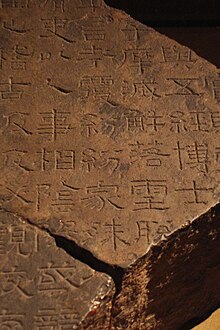Xiping Stone Classics

The Xiping Stone Classics (Chinese: 熹平石經) are a collection of Han dynasty stone carved books on various Confucian classics. Named for the Xiping reign era (AD 172–178) of Emperor Ling of Han, the stone classics were carved over an eight-year period from AD 175 to 183 into stone stelae set up at the Imperial Academy outside Luoyang. The project was overseen by Cai Yong and a group of affiliated scholars who "petitioned the emperor to have the Confucian classics carved in stone in order to prevent their being altered to support particular points of view."[1]
The stelae contained 200,000 characters across 46
The stelae were mostly destroyed in the fighting following the collapse of the Han dynasty in 207, and only a few fragments have survived.
See also
References
- ^ "The Xiping Stone Classics from the National Library of China". World Digital Library.
- ISBN 978-0-674-00249-4.
- ^ "Remains of the Old Luoyang". CCTV-9. 26 August 2011.
- ^ Xiping Stone Classics (熹平石经) (in Chinese)
- ISBN 9789004324916.
External links
- Stone fragments from the Xiping reign in the Chinese stone rubbings database at East Asian Center for Informatics in Humanities, Kyoto University, including two fragments of the classics: 61A and 61B.
